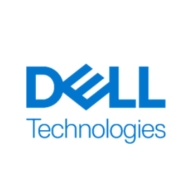
![Dell PowerEdge M [EOL] Logo](https://images.peerspot.com/image/upload/c_scale,dpr_3.0,f_auto,q_100,w_64/nb70b5ansummme9cc5q5ymwyalbv.png)
Dell PowerEdge C and Dell PowerEdge M [EOL] offer exceptional server management in the data center solutions category. PowerEdge C has an edge in compactness, performance, and affordability, whereas PowerEdge M is noted for its scalability and centralized management.
Features: Dell PowerEdge C provides virtualization strength, excellent iDRAC remote server management, and hardware resiliency. Dell PowerEdge M offers future scalability with template-based deployment, scalability features, and centralized management capabilities.
Room for Improvement: Dell PowerEdge C users call for cost reductions, better technical support, and improved AI integration. Dell PowerEdge M faces challenges of EOL status, needing enhanced processing power, network options, and simplified VLAN configurations.
Ease of Deployment and Customer Service: PowerEdge C and M [EOL] are deployed on-premises, with PowerEdge C also used in hybrid environments. Customers find PowerEdge C's deployment straightforward, while PowerEdge M has reliable support despite regional variability.
Pricing and ROI: PowerEdge C's pricing is reasonable but considered expensive by some users, offering competitive quality. PowerEdge M is viewed as expensive yet providing good value through robust performance and delivering positive ROI through efficiency and time savings.
We utilize AI technology with Dell PowerEdge M through a module known as CloudIQ, which provides automation and takes care of predictive analysis and reporting.
They provide excellent help when needed.
Regarding technical support from Dell, I find them to be one of the best support providers in the industry right now.
Regarding scalability, I can scale up to 64 enclosures, and each enclosure can hold around 7 blades.
This is one area where they can improve the performance of the server or implement some application improvements in the solution to make it easier for end users to implement properly.
There are differences in security configurations, particularly in SNMP and SNMP3, between HP ILO and iDRAC.
In terms of potential room for improvement regarding Dell PowerEdge M, I would want to see something such as dense nodes and additional storage, as well as multiple network connectivity on the blades.
Sometimes Dell may be a little costlier, but that is considering the services and solutions we are providing, which can be adjustable.
The ease of troubleshooting and managing through remote access, using tools like iDRAC, significantly saves me time.
If the customer is changing their network infrastructure from 1GB or 10GB to 25GB or 400GB, the MX7000 fabric switch can support that.
| Product | Market Share (%) |
|---|---|
| Dell PowerEdge M | 16.9% |
| PowerEdge C | 1.0% |
| Other | 82.1% |


| Company Size | Count |
|---|---|
| Small Business | 15 |
| Midsize Enterprise | 4 |
| Large Enterprise | 10 |
| Company Size | Count |
|---|---|
| Small Business | 12 |
| Midsize Enterprise | 3 |
| Large Enterprise | 10 |
Dell PowerEdge C is recognized for its ease of use, reliability, scalability, high performance, and flexible customization, making it a cost-effective server solution. It is ideal for hosting virtual machines and managing business, application, and data center services.
PowerEdge C supports stable hybrid environments with its enhanced remote management and virtualization capabilities. It is compatible with Intel processors and provides a tool-less design with an intuitive management interface for seamless operation. Users in telecom and banking rely on its ability to run corporate applications like VOIP and Python, while benefiting from efficient power consumption and compactness. However, there are concerns about update automation, bug issues, integration with AI platforms, and limited expansion capabilities, prompting suggestions for better memory, processing, and improved support, especially around the iDRAC management interface.
What are the key features of Dell PowerEdge C?Telecom and banking industries leverage Dell PowerEdge C to manage corporate applications and virtual environments, supporting private cloud setups and VMware deployments for both internal and client infrastructures. Its adaptability to client budgets allows configurations that range from basic to high-performance computing tasks.
Dell PowerEdge M is known for maximizing efficiency with high core and RAM density, supporting virtual environments and ensuring reliable performance and impressive scalability.
Known for its cost-effectiveness, Dell PowerEdge M offers robust performance and extensive management features like iDRAC and OpenManage for centralized monitoring. It provides strong security capabilities and flexible interface options. Key areas for improvement include boot time delays from POST checks and challenges with iDRAC instance, needing better networking and connectivity options including AMD CPUs and Ethernet enhancements. Users highlight the need for improved scalability, VLAN configurations, and caching. Dell PowerEdge M primarily supports applications like server virtualization and data center consolidation, operating effectively in cluster environments like solar power plant data logging.
What are the key features of Dell PowerEdge M?Dell PowerEdge M finds its implementation in critical applications such as server virtualization and compute, addressing wide-ranging workloads from administrative tasks to scientific computing. Organizations leverage its capabilities in virtual machine hosting, hyper-converged infrastructure management, and balanced load handling, enhancing its effectiveness in environments like solar power plant data logging.
We monitor all Blade Servers reviews to prevent fraudulent reviews and keep review quality high. We do not post reviews by company employees or direct competitors. We validate each review for authenticity via cross-reference with LinkedIn, and personal follow-up with the reviewer when necessary.